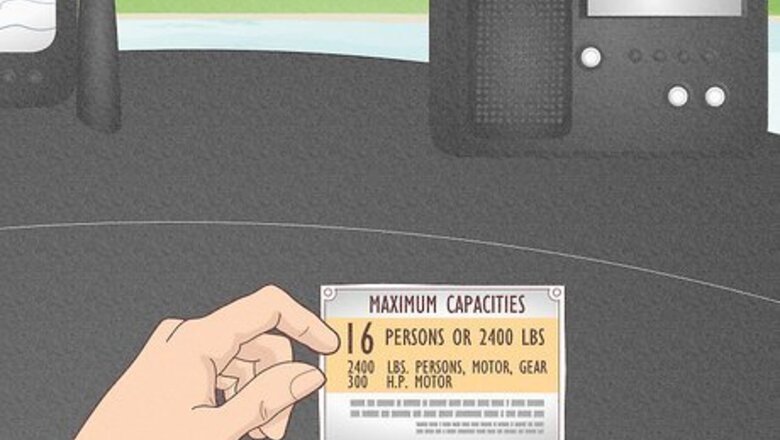
views
- Find a capacity plate near the helm or transom; the capacity plate outlines your vehicle’s max weights.
- If you don’t have a capacity plate, use the formula: number of passengers = boat length (in feet) x boat width (in feet) / 15. This will give you your maximum weight.
- Never exceed your boat’s maximum capacity. If you’re anywhere near the max capacity, go extremely slowly and avoid boating in rough waters.
- Distribute the weight on your boat evenly and keep especially heavy items near the center of the boat to help minimize the weight’s impact.
Read your boat’s capacity plate.
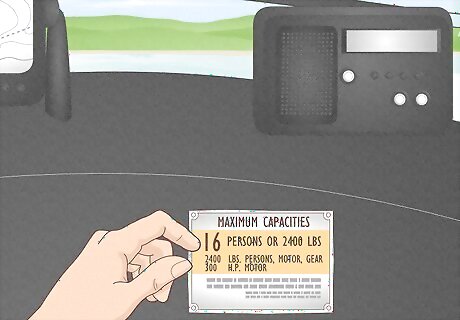
The capacity plate will outline what your weight limits are. A capacity plate is a weatherproof plate that’s permanently attached to your boat. Look around the helm and the transom, which is the flat rear portion at the back of the boat, for your plate. Always follow the plate’s guidelines tot avoid overloading. Depending on the type of boat you have, it will outline an assortment of the following information: The number of passengers allowed on your boat. The max weight of all of your passengers. The maximum combined weight of all gear and passengers. The maximum motor horsepower and weight.
Use the capacity formula if you don’t have a plate.

The formula is number of passengers = boat length x boat width / 15. All measurements are in feet. For every 150 pounds (68 kg) of gear, add an additional person. This will give you a rough estimate of whether you’re at risk of overloading. If you’re within spitting range of the weight limit, you’re at risk of overloading. For example, let’s say your boat is 20 ft long and 13 ft wide. When multiplied together, you get 260. Divide 260 by 15 to get 17.3. Since you can’t carry part of a person, your maximum number of passengers is 17.
Pay attention while you’re loading the boat.
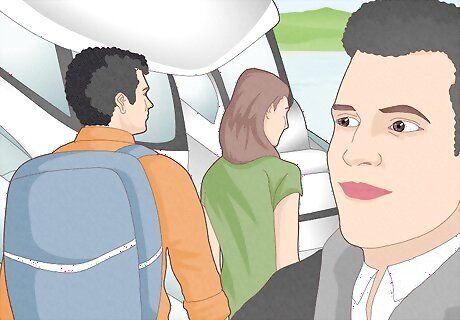
Monitor how much is actually being brought on board before embarking. You don’t need to actually ask for anyone’s weight or do any measuring, but use common sense and take a quick tally. If your estimated math is anywhere near the weight limit, do some more precise measuring before taking off. Even if you are technically under the weight limit, you may want to reconsider embarking. You’ll have to go extremely slow to avoid shifting the weight around and artificially surpassing the limit. Do not remove important safety gear, like extra life jackets or your radio, to create a little extra space for passengers or gear. If your boat is too heavy, you can’t take it out.
Distribute the weight evenly.

The more spread out the weight is, the safer you’ll be on the water. If all of your passengers congregate in one corner of your pontoon, or sit in the back row of your motor boat, kindly ask them to spread out a bit. Don’t pack all of your gear in the same area—spread it out around the center of your boat. Your boat can be thrown radically off balance when all of the weight is shifted to one specific corner of the boat. This can cause you to capsize or lose control when turning or being hit by a wave. If you can choose between putting weight near the center or around the corners, always go for the center. This centralizes the center of gravity and makes it easier to control your boat.
Secure heavy items.
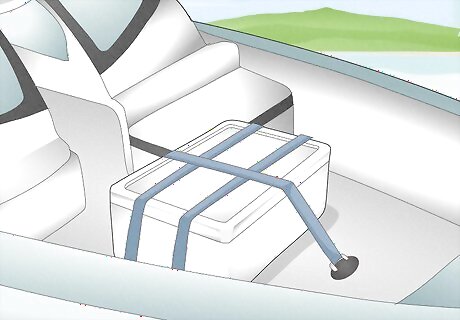
Use tie downs and nylon ropes to fasten any big objects. If you’re carrying any heavy furniture, fishing gear, or coolers, set them near the center of the boat. Use tie downs, nylon ropes, clamps, chains, or hooks to secure the item and keep it from sliding around on the boat when you accelerate or turn a corner. There’s nothing intrinsically wrong with carrying a heavy item so long as you’re under the max weight limit, but you absolutely must ensure the item doesn’t slide around. If you can feel your boat moving as the weight of heavy loads shift in place, you might be close to dangerously overweight.
Avoid heavy loads in bad weather.

Rough waters increase the odds you’ll lose control of the boat. If your family was planning on taking the boat out for a holiday but it’s rough outside, you’re best off skipping the boating. Carrying weight that gets close to your max limit may be okay during normal conditions, but rough waters can radically throw weight around and increase the odds of a capsize. Don’t haul heavy gear when the waters are turbulent. Either keep your boat docked or remove as much unnecessary weight as possible.
Go slow and maintain a reasonable speed.
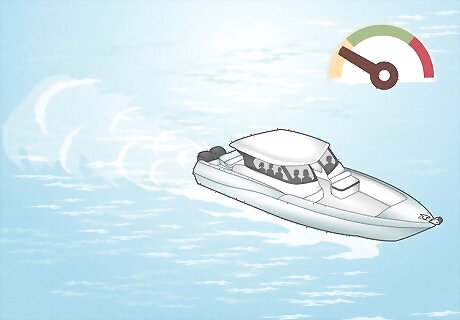
When you’re carrying a lot of weight, it’s important to slow down. This is especially important if you’re a bigger rider on a jet ski or you’ve got passengers on a motorboat, since falling overboard is one of the most dangerous boating emergencies and that’s more common in faster boats. Still, even on a clunky pontoon, you should take it extra slow to stay safe when you’re carrying any extra weight. You should always follow posted speed limits to begin with, but it’s especially important when you’re carrying more weight than you normally would. If there is no speed limit, just go slower than you normally would and use common sense. You should always feel like you’re in control of your boat! You can tell your boat is dangerously overloaded if your boat feels unwieldy even when you’re going at idle or low speeds.
Perform regular boat maintenance.

Extra weight is especially dangerous if your boat isn’t up for the task. Take care of your motor and don’t let your boat sit out during the off season. Check your oil before every outing and test your batteries regularly. If you don’t perform basic maintenance, any weight you add to the boat may be the straw that breaks the camel’s back and leads to a serious maritime emergency. Hire a mechanic to inspect your boat at least once a year. This will keep any minor early issues from getting out of hand.
Use the Plimsoll line if you have one.

Check the exterior of your boat for a weight distribution line. Plimsoll lines are mainly found on commercial tankers, but your boat might have one if a previous owner installed it! Plimsoll lines are horizontal markers that indicate where the water should sit when you’re carrying heavy loads. If you do have a Plimsoll line, do not take the boat out if it’s below the water line. If you see any letters, they refer to water conditions. The symbols are: TF – Tropical fresh water. T – Tropical. F – Fresh water. S – Summer W – Winter. WNA – Winter North Atlantic. AB – Indicates which regulatory body installed and tested the Plimsoll line.




















Comments
0 comment